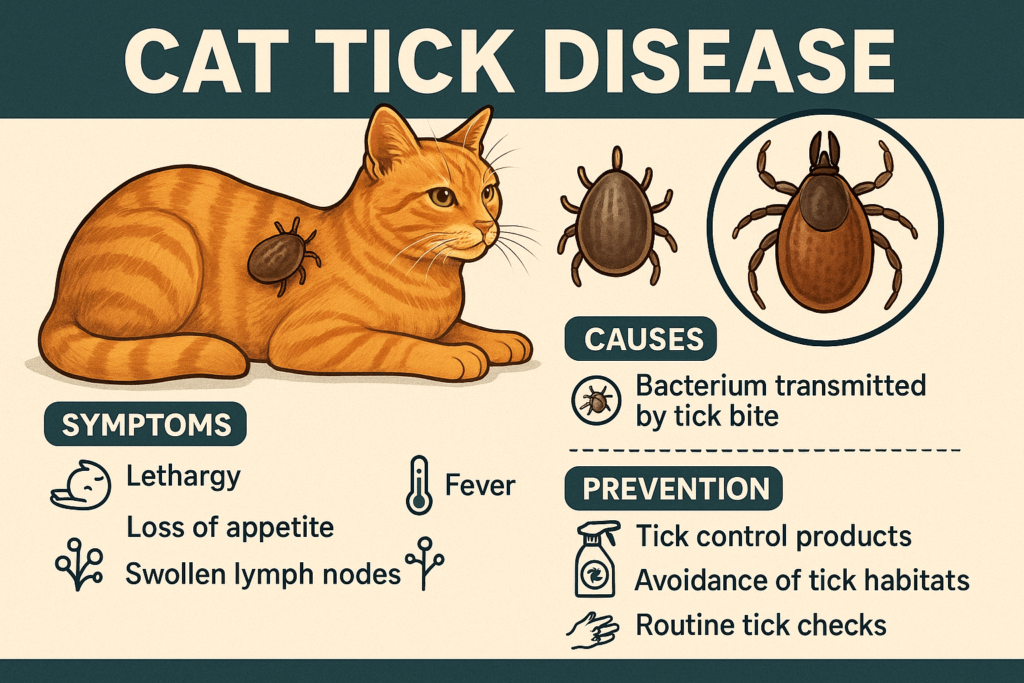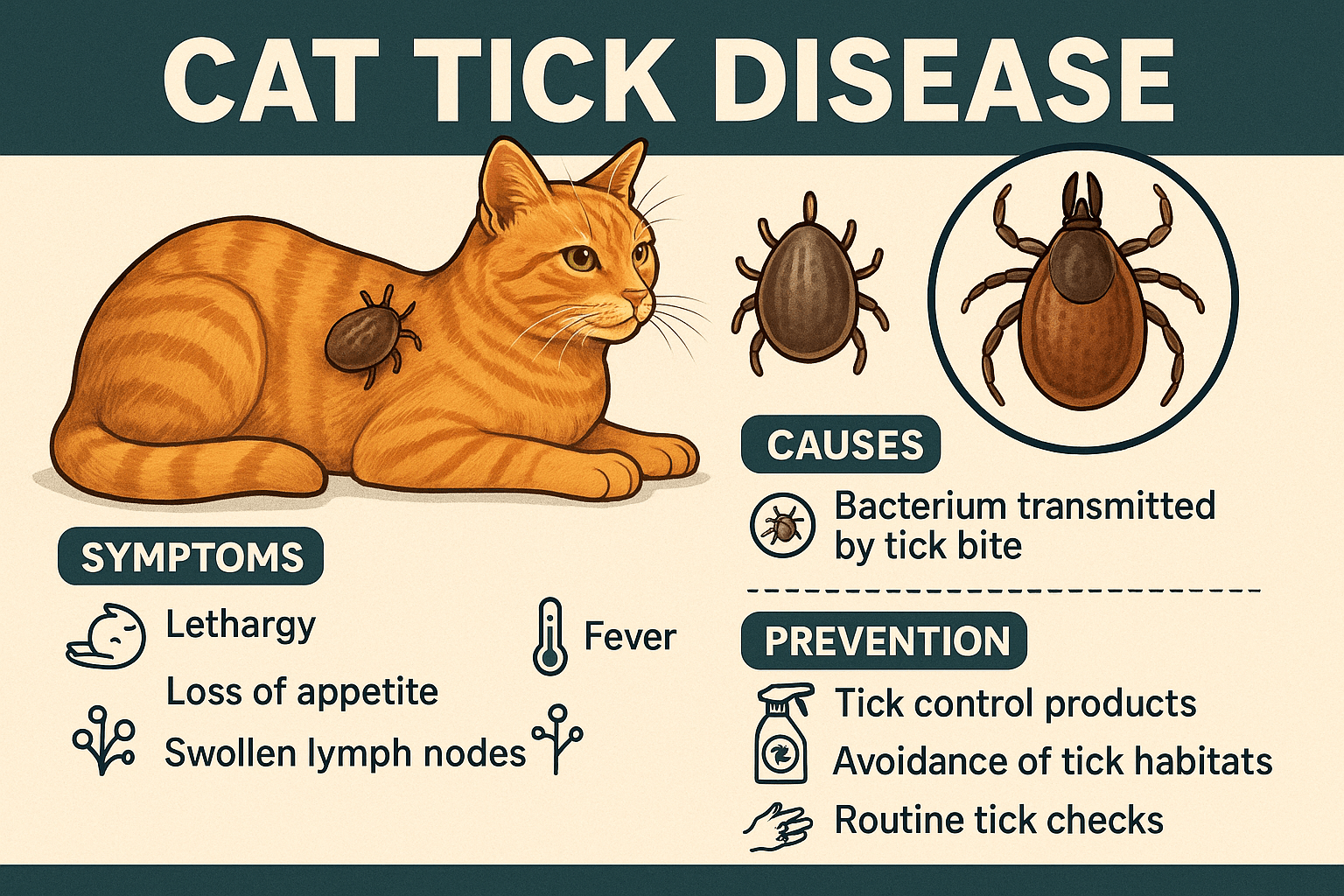Understanding Cat Tick Disease: What Every Pet Owner Needs to Know
Ticks are more than just a nuisance—they can pose serious health risks to your feline companion. Cat tick disease refers to illnesses transmitted by ticks, including Lyme disease, anaplasmosis, and other tick-borne infections. These conditions can lead to symptoms ranging from mild discomfort to severe complications if left untreated. As a responsible cat owner, it’s crucial to understand how ticks affect your pet, recognize the signs of tick-borne diseases, and take preventive measures to protect your furry friend. In this guide, we’ll explore everything you need to know about cat tick disease, from prevention to treatment, ensuring your cat stays healthy and happy.
Expert Insight on Tick Risks for Cats
“Ticks can be found anywhere in the United States and their bite can cause skin infections, anemia, and tick paralysis, which is a serious and life-threatening condition to cats.”
Common Tick-Borne Diseases in Cats
Ticks carry various pathogens that can infect cats, leading to a range of illnesses. Understanding these diseases is the first step toward safeguarding your pet’s health.
Lyme Disease:
Caused by the bacterium Borrelia burgdorferi, Lyme disease can lead to symptoms like lethargy, joint pain, and fever in cats.Anaplasmosis:
This bacterial infection affects the blood cells, causing symptoms such as loss of appetite, fever, and muscle pain.Cytauxzoonosis:
A potentially fatal disease caused by the parasite Cytauxzoon felis, it often results in high fever, jaundice, and difficulty breathing.Ehrlichiosis:
Transmitted by ticks, this disease targets white blood cells and may cause symptoms like weight loss, anemia, and swollen lymph nodes.Tick Paralysis:
While not caused by a pathogen, tick paralysis occurs when a tick’s saliva interferes with nerve function, leading to weakness or paralysis.
Being aware of these common tick-borne diseases allows you to identify potential issues early and seek prompt veterinary care for your cat.

Signs Your Cat May Have a Tick-Borne Disease
Recognizing the symptoms of tick-borne diseases is essential for early intervention. Look out for these warning signs that may indicate your cat has been affected.
Lethargy and Weakness:
If your cat seems unusually tired or reluctant to move, it could be a sign of an underlying tick-related illness.Loss of Appetite:
A sudden disinterest in food is often one of the first indicators of a health problem in cats.Fever or Shivering:
Elevated body temperature or shivering can signal an infection caused by tick bites.Joint Pain or Lameness:
Cats with Lyme disease or similar conditions may experience stiffness or difficulty walking.Jaundice or Pale Gums:
Yellowing of the skin or gums can indicate liver damage or anemia, often associated with tick-borne diseases.
If you notice any of these symptoms, consult your veterinarian immediately to determine the cause and begin treatment.
Check this guide 👉Can You Use Cat Flea Treatment on Dogs? Best 7 Tips!
Check this guide 👉How Often Can You Flea Treat a Cat? Best 7 Expert Tips!
Check this guide 👉Can Fleas Kill a Cat? Best 7 Health Tips!
Preventive Measures Against Ticks | Symptoms of Tick-Borne Diseases |
|---|---|
Regularly check your cat for ticks | Lethargy and weakness |
Use vet-approved tick prevention | Loss of appetite |
Keep your yard free of tall grass | Fever or shivering |
Avoid wooded or overgrown areas | Joint pain or lameness |
Schedule routine vet check-ups | Jaundice or pale gums |
How to Safely Remove a Tick from Your Cat
Finding a tick on your cat can be alarming, but proper removal is key to preventing infection. Follow these steps to safely remove a tick without harming your pet.
Gather the Right Tools:
Use fine-tipped tweezers or a specialized tick removal tool to ensure precision and avoid leaving parts of the tick behind.Wear Gloves:
Protect yourself from potential pathogens by wearing disposable gloves during the removal process.Grasp the Tick Close to the Skin:
Position the tweezers as close to your cat’s skin as possible to avoid squeezing the tick’s body.Pull Straight Upward:
Gently but firmly pull the tick straight out in one motion to reduce the risk of breaking it.Clean the Area Thoroughly:
Disinfect the bite site with antiseptic wipes and wash your hands after removal.
Proper tick removal minimizes the risk of infection and ensures your cat remains comfortable and safe.
Preventing Tick Infestations in Cats
Prevention is always better than cure when it comes to tick-borne diseases. Implementing these strategies can help keep your cat tick-free year-round.
Use Preventive Medications:
Consult your vet about topical treatments, oral medications, or collars designed to repel and kill ticks.Conduct Regular Tick Checks:
Inspect your cat’s fur, especially after outdoor adventures, paying close attention to areas like ears, neck, and paws.Maintain a Tick-Free Environment:
Keep your yard trimmed and free of debris where ticks thrive, and consider using pet-safe insecticides.Limit Outdoor Exposure:
Supervise outdoor time or create a secure enclosure to minimize your cat’s contact with ticks.Bathe Your Cat Regularly:
Gentle bathing with tick-repellent shampoos can help deter ticks and keep your cat clean.
By taking proactive steps, you can significantly reduce the risk of tick infestations and protect your cat’s health.
Risks of Untreated Tick-Borne Diseases
Untreated tick-borne diseases can have serious consequences for your cat’s health. Understanding these risks underscores the importance of timely intervention and treatment.
Chronic Health Issues:
Untreated infections can lead to long-term problems like arthritis or organ damage.Severe Anemia:
Blood loss or destruction of red blood cells can result in life-threatening anemia.Neurological Problems:
Some tick-borne diseases may affect the nervous system, causing seizures or paralysis.Weakened Immune System:
Prolonged illness can compromise your cat’s immune system, making them vulnerable to other infections.Fatality in Severe Cases:
Without treatment, certain diseases like cytauxzoonosis can be fatal within days.
Addressing tick-borne diseases early is crucial to preventing these devastating outcomes.
Natural Remedies for Tick Prevention
While chemical treatments are effective, some pet owners prefer natural alternatives for tick prevention. These remedies can complement traditional methods but should not replace vet-approved solutions.
Essential Oils (Diluted):
Certain oils like lavender or cedarwood may repel ticks when diluted and applied carefully.Apple Cider Vinegar Spray:
A diluted spray can act as a natural deterrent, though its effectiveness varies.Herbal Collars:
Some collars infused with herbs claim to repel ticks without harsh chemicals.Diatomaceous Earth:
This fine powder can be sprinkled in your home or yard to kill ticks naturally.Probiotics for Immune Support:
Boosting your cat’s immune system with probiotics may help them fight off infections.
Natural remedies can be helpful but should always be used cautiously and under veterinary guidance.
When to Visit the Vet
Knowing when to seek professional help is vital for managing tick-related issues effectively. Here are some scenarios that warrant an immediate vet visit.
Persistent Symptoms:
If your cat shows ongoing signs of illness despite treatment, further evaluation is necessary.Difficulty Breathing:
Labored breathing could indicate a severe tick-borne disease requiring urgent care.Sudden Collapse or Paralysis:
Immediate medical attention is needed if your cat experiences sudden weakness or paralysis.Unexplained Weight Loss:
Significant weight loss may signal a chronic condition linked to tick-borne infections.High Fever That Won’t Subside:
A persistent high fever indicates a serious underlying issue that needs prompt diagnosis.
Your vet is your best resource for addressing tick-related health concerns and ensuring your cat receives the care they need.
Frequently Asked Questions About Cat Tick Disease
Can indoor cats get ticks?
Yes, ticks can hitchhike indoors on clothing, pets, or even rodents, so indoor cats aren’t completely immune.
What should I do if I find a tick on my cat?
Remove the tick promptly using proper techniques and monitor your cat for any signs of illness.
What should I do if I find a tick on my cat?
Not all ticks carry diseases, but it’s best to assume they do and take precautions accordingly.
Can tick-borne diseases be cured?
Many tick-borne diseases can be treated with antibiotics or other medications if caught early.
How often should I check my cat for ticks?
Check your cat daily during peak tick season and after outdoor activities to catch infestations early.
Protecting Your Cat from Tick-Borne Diseases
Ticks may be small, but their impact on your cat’s health can be significant. By staying informed about cat tick disease, recognizing the signs of infection, and implementing preventive measures, you can ensure your feline friend remains healthy and happy. Early detection and prompt treatment are key to managing tick-borne illnesses effectively. With vigilance and care, you can keep ticks at bay and enjoy peace of mind knowing your beloved pet is safe from harm.
Cuterebra Larvae in Cats: Best 7 Expert Tips! – Expert advice on signs, treatment & prevention of this rare but serious feline parasitic infestation.
Cuterebra Larvae in Dogs: Best 7 Expert Tips! – Expert advice on signs, treatment & prevention of this rare but serious parasitic infestation.
Cat Tumor on Paw: Best 7 Expert Tips! – Expert advice on signs, diagnosis, treatment & care for feline paw tumors.
Panacur Side Effects in Dogs: Best 7 Expert Tips! – Safe usage, common reactions & when to call the vet.





